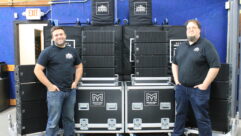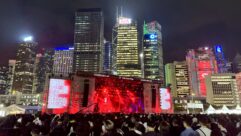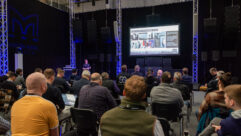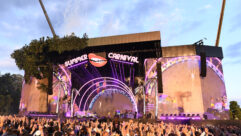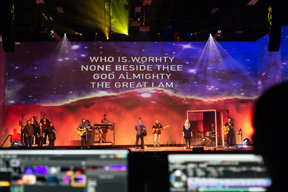
SVC Podcast – Show Notes – Show 131-2:
In this edition of the SVC Podcast, SVC Contributing Editor Bennett Liles talks with Minister of Communication Allen Hendrix of the Broadmoor Baptist Church in Shreveport, Louisiana about outfitting their new building with a Martin Audio MLA Mini speaker system, Audio-Technica wireless mics and a Yamaha CL-3 mixer. Allen outlines the acoustical challenges the church faced in the all metal building with a high energy worship style.
Links of interest:
- The Broadmoor Baptist Church in Shreveport, Louisiana
- The Audio-Technica 5000 Series wireless microphone system
- The Martin Audio MLA Mini speaker system used for the main house
- The Yamaha CL-3 mixer chosen for the church
Download Podcast Here:
https://s3.amazonaws.com/nb-svc/public/public/131-2_Broadmoor_Baptist_A_…
From Sound & Video Contractor Magazine, this is the SVC Podcast with Allen Hendrix. Show notes for the podcast are available on the web site of Sound & Video Contractor Magazine at svconline.com.
The Broadmoor Baptist Church in Shreveport is growing so fast they’ve been through several venues but the latest was built for space, not necessarily acoustics so they put in a Martin Audio MLA Mini sound system for better control. Minister of Communications Allen Hendrix is going to tell us how it was all done. That’s coming up next on the SVC Podcast.
Allen, it’s great to have you with us on the SVC Podcast from Broadmoor Baptist Church in Shreveport. You’ve got a church that has had a few growing pains but it is growing fast. What sort of a worship style does Broadmoor Baptist have?
Well first of all, thanks for having me on your podcast. Broadmoor Baptist has a pretty wide range of worship style formats. We have seven specific venues on campus. Although it’s not a super large church, seven venues is large for, I think, any church. Also that includes, by the way, the venues for our preschool and children’s worship and for all of our age-rated areas as well. So we qualified those with full outfits for light, sound and video across the board for all ages. We have two primary worship venues that we have for adults. One is called Worship Center North and one is called Worship Center South. Worship Center North is our more traditional configuration, so when you talk about a Baptist church in the Bible Belt in North Louisiana it’s what you imagine it would be; pretty traditional organ and orchestra, a large choir, a balcony, and the format is what some people would refer to as blended. We do hymns and praise choruses with a praise team, but it is worship leader driven. He doesn’t play a guitar or sit at a piano. He stands behind the podium and will direct the congregational singing and choir anthems. So that’s the format for Worship Center North. Worship Center South, which is our faster-growing group is what we refer to as full-on contemporary. We often refer to it as our rock-and-roll service. It’s 100 percent Christian music. We don’t really play secular music in that room, although some people will say that it sounds that way just because it’s guitar driven, and so guitar, bass, drums. It is typically led by four or five singers up front. Occasionally we’ll have a praise choir, but that’s typically no more than about six or eight people and so that’s the primary format that we use in the new space. It has grown from what we used to refer to as an overflow seating alternate congregation or alternate style with about 100 people as short as eight years ago all the way up to now with a new 1,200-seat worship space. We moved from a 100-seat chapel to half of a gymnasium to a complete gymnasium to adding in dining space that was connected to the gymnasium and now into its own space. [Timestamp: 3:11]
With this fast growing church you’ve now got this new big building that’s providing the space you need, but I guess it wasn’t really designed for acoustics.
No, it definitely wasn’t. Our big push point is just how many seats can we get in it. Our church is debt free, which basically means that we don’t turn a spade in the dirt unless there’s money in the bank. Because of our greatest need was being able to get everyone in one room – and by the way, we run multiple service hours, so we wanted to try to get something that would be affordable for us; at the same time be able to accommodate as many people under one roof as we could. And so with a very fixed budget of however much money we could raise within a certain time span, which came into just over $4 million. And so with that money in the bank we were given the green light to the building committee to go after an architect and a builder, to bring in people’s concepts of how would they do it for that amount of money and we received five recommendations from different contractors and their subs and ended up whittling that down to one particular contractor which was a design/build option. What we ended up with was a metal constructed building, which was the most affordable way to go as opposed to even a concrete flex wall, which is kind of a newer technology for building where it’s preformed concrete panels that you would connect. A lot of shopping malls do that these days. The metal building was going to be the cheapest way for us to do it and that brought with it quite a few issues for us acoustically, as you can imagine. [Timestamp: 4:44]
Yeah I would think reverberation, but at least you got more cubic space for more cubic dollars.
That was the goal for sure. We were able to get a few things – some slight adjustments and recommendations. The budget didn’t really afford us to be able to have an acoustician on the design team. The architect did what he could to lessen the impact of parallel walls by doing some surface treatment and angles in the walls, on the sidewalls specifically. But the issue for us was really the front and back walls ended up being straight up parallel. So trying to design an audio system where we knew that we had to overcome a reverberant time and space, which was literally at 1K, going to be something in the five second range in reverb, which was great for congregational singing and an organ if we ever wanted to have one in there, but of course we didn’t. And so we had to figure out what to do with that. Initially knowing that adding in our chairs and the people and a carpeted floor, we still needed to find a PA system that was going to put the sound where we wanted it and not where we didn’t need it. [Timestamp: 5:50]
And so you went with the Martin Audio MLA Mini?
That’s correct.
And what was the attraction there, just being able to control the sound better?
It really was the high predictability of what the MLA could give us. I demoed that system at Infocomm last year in Las Vegas and we went on a hunt – literally a scavenger hunt – to try to figure out what system was going to be best for us. We listened to, well, pretty much every manufacturer that had a demo space with large-scale reinforcement systems being demonstrated at the show and we were able to narrow our choices down to about three and then from that we spent an extra day going back and listening and talking to engineers and trying to get a better handle on which one of those three was going to be the best for us and we settled on the Martin primarily because they have the ability to steer the overall system. It’s not an individual transducer that we’re working with, but it’s a combination. And I was really impressed by the technology that they use and just really the thought process that they use to be able to say, “We can’t in good conscience be able to take a single element or a single device, a single enclosure out of an array and analyze that whether it’s an anechoic chamber or test modules or however you want to do a testing simulation in it.” An array has to be done with all of its components in place in order to get a definitive path as to how the enclosure’s going to work together. And so they have a way of being able to say there are two options really. You can have a single power plant with four foam boxes underneath it or you can have two power plants with eight boxes and that’s the option, those two combinations. With those two combinations they have a very definitive way of steering the sound and more importantly predicting what the coverage path is going to be. And so although there’s a compromise – in our mind initially there was a compromise to say, “Is that number of boxes going to be able to cover our room? If we added one more to that bottom” – well, there’s not an option to add one more. That’s what you get. But all in all it was more than enough for us to get the right coverage that we needed. It was predicted very well and then more importantly once we got the system in, the ability to be able to listen to different configurations without having to go up to the arrays and move them. So basically a single hang with the DSP control giving us the option to be able to literally steer sound away from certain areas. [Timestamp: 8:12]
And I think you’ve got some front fills on there with some sub-woofers, too?
We do, and then that was one of the things in our space because the ceiling trim that we needed to get the speaker system high enough, this room also has a very elaborate environmental projection system in it that equates to a coverage area 130 feet wide by 16 feet tall with seven projectors across a wide span with three more projectors firing on top of that for IMAG. And so because of the visual package that we put in place on our back wall – or the stage wall I should say – for the environmentals, we wanted to make sure the shadows weren’t going to be in issue. So that required the speaker system be trimmed pretty high – as high as we could get it. And so of course at that particular ceiling height it was nearly impossible to get a down-filled package to hit the first two or three rows so we did add in a near field system on the edge of the stage just to cover that so there’s not going to be a propagation delay really in trying to keep that coming in from the top. It’s all right there in the front. [Timestamp: 9:10]
That sounds like there might have been a lot of cabling to run through that metal building. Were there any problems with that?
Not really. Because we’re just sending a single source to each of those arrays, all the cabling and the power plants run at the box. So all you need at the speaker system itself is A/C power, obviously, because it’s a powered system, your audio program content line, and then a control line. And so basically it’s power up there, audio and control and you’re done. And so the Martin base enclosure, which is a 15-inch cone enclosure that’s about 20 inches square, on the back of that is mounted what they call the power module. The power module has the DSP control in it. It has nine channels of Class D amplification in it. One channel is for the sub itself and then eight more channels available for the eight boxes that hang underneath it. So it’s all pretty tight and compact up there and so the wiring for us was actually very, very easy. [Timestamp: 10:07}
And you’ve got an Audio-Technica wireless mic system. Not a bad choice there. How’s that been doing?
Very, very well. This room, because of the metal structure, has some interesting issues to it. It’s kind of funny. We have zero cellular coverage inside the room. It’s like a metal box. So although there are plenty of cellular towers around us it’s next to impossible to get a cellular signal inside the building. So we’ve had to bring in some extenders to be able to have cell phone coverage inside the space. So anytime you’re working with wireless environment like that there’s always some questions, but the 5000 series has been a workhorse for us not just in this space but over the years we’ve had it in all of our venues. We like the ability to be able to monitor it. We have the software control on it and so we can monitor that from the booth to look at battery strength and signals and things like that. So it works well because we have so many of them on campus to be able to block those down and share them across sometimes if we need one or two from the north we can bring them down and they work well and interface well with all of our other systems. I’m a believer of that, any system that you put in place in one venue you want to have matching sets in other venues so if you need to grow one or pull down the other or something fails you can share equipment across all the rooms. We do that also for training purposes so when we have volunteers we train them on systems, not necessarily the space. And so where there’s the console or the audio system or microphone systems that we use we try to standardize that across all of our venues so that training becomes very easy. [Timestamp: 11:33]
It looks like the Yamaha CL-3 console was a perfect balance for the features and the live music and everything but still easy to train volunteers on.
The lack of buttons is easy for us to entice volunteers to become a part of what we do. And I didn’t think that would be the case because it’s digital and initially my thought would be – of course we’ve been doing the Yamaha digital consoles for a long time, but when you see a lot of knobs on a desk sometimes volunteers kind of panic or the potential volunteer will panic and go, “I don’t think I can wrap my brain around what all these knobs do.” The reality is there’s just one channel strip repeated 48 times or something like that. The system also includes a QL console, the new QL console, which we use in our broadcast mix for streaming and for television. The interface, though, is the same across both of those boards and that makes it super easy again for training, but it’s also the fewer knobs the better, I think, when we’re working with volunteers. We just want them to mix. We don’t necessarily need them to tweak. That’s our technical director’s responsibility to fine tune all that stuff. So it’s been a really nice piece to have in our space. [Timestamp: 12:36]
And one of the greatest things about digital audio boards for churches and being operated by volunteers is that you can always get it back to where it was.
That’s right. Yeah, exactly; it’s a great option.
So how long did the whole project take from start to finish?
It took longer than it needed to take. We got into issues with the weather – one of the wettest and coldest winters that we’ve had here in Shreveport and by far the wettest spring. We did not publish a grand opening date until a month before we opened and the reason was because all the dates we had kind of written for inside words – in other words when our inside projection dates were going to be – had all been pushed back a number of weeks since January. So because of the delays in our weather and other issues, it’s one of the things we always talk about as good, fast and cheap from a design standpoint. Everybody wants your project to be good and fast and cheap, but the reality is you can only have two of those. You can’t have it be good, fast and cheap. You can have it good and you can have it fast, but it’s going to be expensive. And since cheap, or inexpensive as we like to say around here, was our big thing and we want it to be good, then we knew it would take a long time. That’s just one of the compromises that we got to deal with before that. So I would say all in all it ended up, although they told us it takes about 11 months it ended up taking about 16. [Timestamp: 13:53]
And I know you’ve probably got a range of different seating layouts there. Are there different sound system setups for those or does one size pretty much fit all?
It does and that’s one of the benefits we have in a movable seating configuration. We chose very, very early in the design process that we would not put fixed seating in the room. From a contemporary worship standpoint we know based upon our history – and we – of course Broadmoor Baptist has been around 85 years and even our contemporary worship has been here 10 years – but we still know what seasons do. We know what our Sundays are going to look like. We know what our school schedules are going to be, how that impacts attendance. So one of the things we didn’t want to do is put a whole lot of seating in the space but then not be able to put people in all those seats because then it feels like you have an empty room. So we have the ability to widen the aisles and increase the row spacing based upon what we are projecting our crowd size will be. And so we can max out at 1,200 seats but we can also more comfortably put in about 850 seats, which would be our smallest configuration. But then we also do student ministry in there on Wednesday nights and that particular configuration we can put as few as, say, 200 in that space and make it not feel like it’s huge. And we can do that by turning zone lighting out on the side walls. We can pipe and drape off some areas, spread the seats out a little bit, and that makes it feel a lot fuller than it would otherwise. [Timestamp: 15:18]
Well, that’s great. You have a varied congregation and when they come in they know what to expect. So what’s been the reaction from the congregation so far?
Well considering we came from a converted basketball gym into this new space, I think that the response has been very, very positive. You hope that it would be anyway. But I think our team, I’ve been very, very blessed to have great people around me and super creative so that brings a very wide palette of tools that we can put in play. And so especially with the environmental projection environments that we have – like I said, there’s seven projectors in the EP side, there’s three projectors on the IMAG side. There’s another two projectors on the back wall for prompting and confidence. We didn’t spend an enormous amount of money in lighting because we have so many visual elements in live video and projection and so that was kind of a balance that we did there to be real flexible. But I think overwhelmingly our congregation has been in awe by it and one of our goals is always to say my desire is to create a worship environment where people leave with this thought on their mind. I want them to imagine who can they invite to church next week. That’s my goal. I want them to walk out knowing so-and-so needs to be here with me next week and that’s the key for me is to get people to invite their friends to come not just to see what this is, but to experience what the Holy Spirit can do amongst His people. So that’s kind of where we’re at. [Timestamp:16:44]
Well, you’ve got all the technical elements lined up with Audio-Technica and Yamaha and the Martin Audio MLA Mini. It sounds like you’ve gotten off on the right track and people can get in the spirit without having to worry about tech problems. It’s Allen Hendrix with Broadmoor Baptist Church in Shreveport. Thanks so much for telling us about this one.
Thank you very much for having me.
Thank you for being here with us for the SVC Podcast with Allen Hendrix. Show notes are available on the website of Sound & Video Contractor Magazine at svconline.com. Join us again next time for the SVC Podcast.


